Numerical Optimization of Multi-Stage Thermoelectric Cooling Systems Using Bi2Te3 for Enhanced Cryosurgical Applications
Abstract
1. Introduction
2. Materials and Methods
2.1. Three-Dimensional TE Model
2.2. General TE Equations
2.3. TE Material Properties and Boundary Conditions
3. Results
3.1. Single-Stage (SS) TEC Performance Analysis
3.1.1. Thermal and Electrical Performance Analysis
3.1.2. Comparative Analysis of Temperature Difference
3.1.3. Electrical and Thermal Performance Characteristics
3.1.4. Electric Power Consumption Evaluation
3.1.5. Geometry and Performance Evaluation
3.1.6. Coefficient of Performance (COP) Analysis
3.1.7. Limitations and MS Design Implications
3.2. Multi-Stage (MS) TEC Performance Analysis
3.2.1. Spatial Distribution Analysis
3.2.2. Comparative Analysis of Temperature Difference vs. Input Current
3.2.3. Electrical and Thermal Performance Characteristics
3.2.4. Comparative Analysis of Electric Power Consumption
3.2.5. Implications for Cryosurgical Applications
4. Conclusions
Author Contributions
Funding
Data Availability Statement
Acknowledgments
Conflicts of Interest
References
- Zabek, D.; Morini, F. Solid state generators and energy harvesters for waste heat recovery and thermal energy harvesting. Therm. Sci. Eng. Prog. 2019, 9, 235–247. [Google Scholar] [CrossRef]
- Wang, C. Recent progress in thermoelectric materials, devices and applications. Kexue Tongbao/Chin. Sci. Bull. 2021, 66, 2024–2032. [Google Scholar] [CrossRef]
- Ochieng, A.O.; Megahed, T.F.; Ookawara, S.; Hassan, H. Comprehensive review in waste heat recovery in different thermal energy-consuming processes using thermoelectric generators for electrical power generation. Process Saf. Environ. Prot. 2022, 162, 134–154. [Google Scholar] [CrossRef]
- Baskaran, P.; Rajasekar, M. Recent trends and future perspectives of thermoelectric materials and their applications. RSC Adv. 2024, 14, 21706–21744. [Google Scholar] [CrossRef] [PubMed]
- Wang, J.; Wang, J.B.; Long, Z.Y.; Zhu, T.; Li, Z.S.; Jiang, Z.C.; Liu, J. Design and application of a cooling device based on peltier effect coupled with electrohydrodynamics. Int. J. Therm. Sci. 2021, 162, 106761. [Google Scholar] [CrossRef]
- Hafid, M.; Lacroix, M. Fast inverse prediction of the freezing front in cryosurgery. J. Therm. Biol. 2017, 69, 13–22. [Google Scholar] [CrossRef]
- Zohuri, B. Cryogenics and Liquid Hydrogen Storage. In Hydrogen Energy: Challenges and Solutions for a Cleaner Future; Springer International Publishing: Cham, Switzerland, 2019; pp. 121–139. [Google Scholar] [CrossRef]
- Mahek, M.K.; Ramadan, M.; Dol, S.S.B.; Ghazal, M.; Alkhedher, M. A comprehensive review of thermoelectric cooling technologies for enhanced thermal management in lithium-ion battery systems. Heliyon 2024, 10, e40649. [Google Scholar] [CrossRef]
- Sun, Q.; Du, C.; Chen, G. Thermoelectric materials and devices: Applications in enhancing building energy conversion and efficiency. Adv. Nanocompos. 2025, 2, 15–31. [Google Scholar] [CrossRef]
- Twaha, S.; Zhu, J.; Yan, Y.; Li, B. A comprehensive review of thermoelectric technology: Materials, applications, modelling and performance improvement. Renew. Sustain. Energy Rev. 2016, 65, 698–726. [Google Scholar] [CrossRef]
- Mamur, H.; Bhuiyan, M.R.A.; Korkmaz, F.; Nil, M. A review on bismuth telluride (Bi2Te3) nanostructure for thermoelectric applications. Renew. Sustain. Energy Rev. 2018, 82, 4159–4169. [Google Scholar] [CrossRef]
- Li, Y.; Li, W.; Han, T.; Zheng, X.; Li, J.; Li, B.; Fan, S.; Qiu, C.-W. Transforming heat transfer with thermal metamaterials and devices. Nat. Rev. Mater. 2021, 6, 488–507. [Google Scholar] [CrossRef]
- Guclu, T.; Cuce, E. Thermoelectric Coolers (TECs): From Theory to Practice. J. Electron. Mater. 2019, 48, 211–230. [Google Scholar] [CrossRef]
- Najafi, H.; Woodbury, K.A. Optimization of a cooling system based on Peltier effect for photovoltaic cells. Sol. Energy 2013, 91, 152–160. [Google Scholar] [CrossRef]
- Astrain, D.; Vián, J.G.; Albizua, J. Computational model for refrigerators based on Peltier effect application. Appl. Therm. Eng. 2005, 25, 3149–3162. [Google Scholar] [CrossRef]
- Witting, I.T.; Chasapis, T.C.; Ricci, F.; Peters, M.; Heinz, N.A.; Hautier, G.; Snyder, G.J. The Thermoelectric Properties of Bismuth Telluride. Adv. Electron. Mater. 2019, 5, 1800904. [Google Scholar] [CrossRef]
- Liu, K.; Li, Y.Z.; Wu, Y.X.; Ying, P.J.; He, R.; Fu, C.G.; Zhang, Y.; Zhu, T.J. Application requirements and design strategies of Bi 2 Te 3 -based thermoelectric devices for low-quality thermal energy. cMat 2024, 1, e11. [Google Scholar] [CrossRef]
- Bhuiyan, M.R.A.; Korucu, H.; Mamur, H.; Haque, M.M. Growth and characterization of Bi2Te2.70Se0.30 nanostructured materials by using a cost-effective chemical solution route. J. Alloy. Metall. Syst. 2023, 4, 100032. [Google Scholar] [CrossRef]
- Kherkhar, A.; Chiba, Y.; Tlemçani, A.; Mamur, H. Thermal investigation of a thermoelectric cooler based on Arduino and PID control approach. Case Stud. Therm. Eng. 2022, 36, 102249. [Google Scholar] [CrossRef]
- Hasan, M.K.; Haque, M.M.; Üstüner, M.A.; Mamur, H.; Bhuiyan, M.R.A. Optimizing the performance of Bi2Te3 TECs through numerical simulations using COMSOL multiphysics. J. Alloy. Metall. Syst. 2024, 5, 100056. [Google Scholar] [CrossRef]
- Jaziri, N.; Boughamoura, A.; Müller, J.; Mezghani, B.; Tounsi, F.; Ismail, M. A comprehensive review of Thermoelectric Generators: Technologies and common applications. Energy Rep. 2020, 6, 264–287. [Google Scholar] [CrossRef]
- Zhang, J.Y.; Xia, C.; Wang, H.F.; Tang, C. Recent advances in electrocatalytic oxygen reduction for on-site hydrogen peroxide synthesis in acidic media. J. Energy Chem. 2022, 67, 432–450. [Google Scholar] [CrossRef]
- Aliabadi, P.; Mahmoud, S.; AL-Dadah, R.K. Simulation of Cascaded Thermoelectric Devices for Cryogenic Medical Treatment. In Proceedings of the 2014 COMSOL Conference in Cambridge; 2014; pp. 1–4. [Google Scholar]
- Chen, L.; Liu, R.; Shi, X. Thermoelectric Materials and Devices; Elsevier: Amsterdam, The Netherlands, 2020. [Google Scholar] [CrossRef]
- Hu, B.; Shi, X.L.; Zou, J.; Chen, Z.G. Thermoelectrics for medical applications: Progress, challenges, and perspectives. Chem. Eng. J. 2022, 437, 135268. [Google Scholar] [CrossRef]
- Whaley, D.; Damyar, K.; Witek, R.P.; Mendoza, A.; Alexander, M.; Lakey, J.R.T. Cryopreservation: An Overview of Principles and Cell-Specific Considerations. Cell Transplant. 2021, 30, 1–12. [Google Scholar] [CrossRef] [PubMed]
- Zaferani, S.H.; Sams, M.W.; Ghomashchi, R.; Chen, Z.G. Thermoelectric coolers as thermal management systems for medical applications: Design, optimization, and advancement. Nano Energy 2021, 90, 106572. [Google Scholar] [CrossRef]
- Tan, G.; Zhao, L.-D.; Kanatzidis, M.G. Rationally Designing High-Performance Bulk Thermoelectric Materials. Chem. Rev. 2016, 116, 12123–12149. [Google Scholar] [CrossRef]
- Kroon, R.; Mengistie, D.A.; Kiefer, D.; Hynynen, J.; Ryan, J.D.; Yu, L.; Müller, C. Thermoelectric plastics: From design to synthesis, processing and structure-property relationships. Chem. Soc. Rev. 2016, 45, 6147–6164. [Google Scholar] [CrossRef]
- Amengual, A.; Isalgue, A.; Marco, F.; Tachoire, H.; Torra, V.; Torra, V.R. Automatic equipment with improved performances (ATD and DSC) in shape memory alloys studies. J. Therm. Anal. 1992, 38, 583–592. [Google Scholar] [CrossRef]
- Drebushchak, V.A. The Peltier effect. J. Therm. Anal. Calorim. 2008, 91, 311–315. [Google Scholar] [CrossRef]
- Modak, R.; Murata, M.; Hou, D.; Miura, A.; Iguchi, R.; Xu, B.; Guo, R.; Shiomi, J.; Sakuraba, Y.; Uchida, K.I. Phase-transition-induced giant Thomson effect for thermoelectric cooling. Appl. Phys. Rev. 2022, 9, 011414. [Google Scholar] [CrossRef]
- Thomson, W. 4. On a Mechanical Theory of Thermo-Electric Currents. Proc. R. Soc. Edinb. 1857, 3, 91–98. [Google Scholar] [CrossRef]
- Snyder, G.J.; Snyder, A.H. Figure of merit ZT of a thermoelectric device defined from materials properties. Energy Environ. Sci. 2017, 10, 2280–2283. [Google Scholar] [CrossRef]
- Abol-Fotouh, D.; Dörling, B.; Zapata-Arteaga, O.; Rodríguez-Martínez, X.; Gómez, A.; Reparaz, J.S.; Laromaine, A.; Roig, A.; Campoy-Quiles, M. Farming thermoelectric paper. Energy Environ. Sci. 2019, 12, 716–726. [Google Scholar] [CrossRef] [PubMed]
- Cervino-Solana, P.; Ramirez-Peral, M.J.; Martín-González, M.S.; Caballero-Calero, O. Thermoelectric bismuth telluride nanostructures fabricated by electrodeposition within flexible templates. Heliyon 2024, 10, e36114. [Google Scholar] [CrossRef] [PubMed]
- Cao, T.; Shi, X.L.; Li, M.; Hu, B.; Chen, W.; Liu, W.D.; Lyu, W.; MacLeod, J.; Chen, Z.G. Advances in bismuth-telluride-based thermoelectric devices: Progress and challenges. eScience 2023, 3, 100122. [Google Scholar] [CrossRef]
- Kishore, R.A.; Kumar, P.; Sanghadasa, M.; Priya, S. Taguchi optimization of bismuth-telluride based thermoelectric cooler. J. Appl. Phys. 2017, 122, 25109. [Google Scholar] [CrossRef]
- Lu, T.; Zhang, X.; Zhang, J.; Ning, P.; Li, Y.; Niu, P. Multi-objective optimization of thermoelectric cooler using genetic algorithms. AIP Adv. 2019, 9, 095105. [Google Scholar] [CrossRef]
- Hao, J.; Qiu, H.; Ren, J.; Ge, Z.; Chen, Q.; Du, X. Multi-parameters analysis and optimization of a typical thermoelectric cooler based on the dimensional analysis and experimental validation. Energy 2020, 205, 118043. [Google Scholar] [CrossRef]
- Venkatesan, K.; Venkataramanan, M. Experimental and Simulation Studies on Thermoelectric Cooler: A Performance Study Approach. Int. J. Thermophys. 2020, 41, 38. [Google Scholar] [CrossRef]
- Vikhor, L.; Lysko, V.; Kotsur, M.; Havrylyuk, M. Approach to improving the energy efficiency of thermoelectric coolers for IR detectors. J. Appl. Phys. 2025, 137, 094503. [Google Scholar] [CrossRef]
- Oktaviani, A.; Hendryani, A.; Sambiono, A. Development of a Multi-Stage Thermoelectric Cryosurgery Prototype for Skin Cancer Treatment. J. Med. Electron. 2024, 1, 8–12. [Google Scholar]
- Cheng, K.; Qin, J.; Jiang, Y.; Zhang, S.; Bao, W. Performance comparison of single- and multi-stage onboard thermoelectric generators and stage number optimization at a large temperature difference. Appl. Therm. Eng. 2018, 141, 456–466. [Google Scholar] [CrossRef]
- Hu, S.; Song, J.; Wu, C.; Lei, T.; Li, H.; Shi, S.; Zhao, X.; Zhang, G.; Huo, Y. A portable design and demonstration of two-stage thermoelectric cooling system for 200 K cryogenic applications. Appl. Therm. Eng. 2025, 268, 125838. [Google Scholar] [CrossRef]
- Karimi, G.; Culham, J.R.; Kazerouni, V. Performance analysis of multi-stage thermoelectric coolers. Int. J. Refrig. 2011, 34, 2129–2135. [Google Scholar] [CrossRef]
- Chauhan, N.S.; Mori, T. Cooler, stronger, smaller: Improving thermoelectric cooling. Natl. Sci. Rev. 2025, 12, 2024–2025. [Google Scholar] [CrossRef] [PubMed]
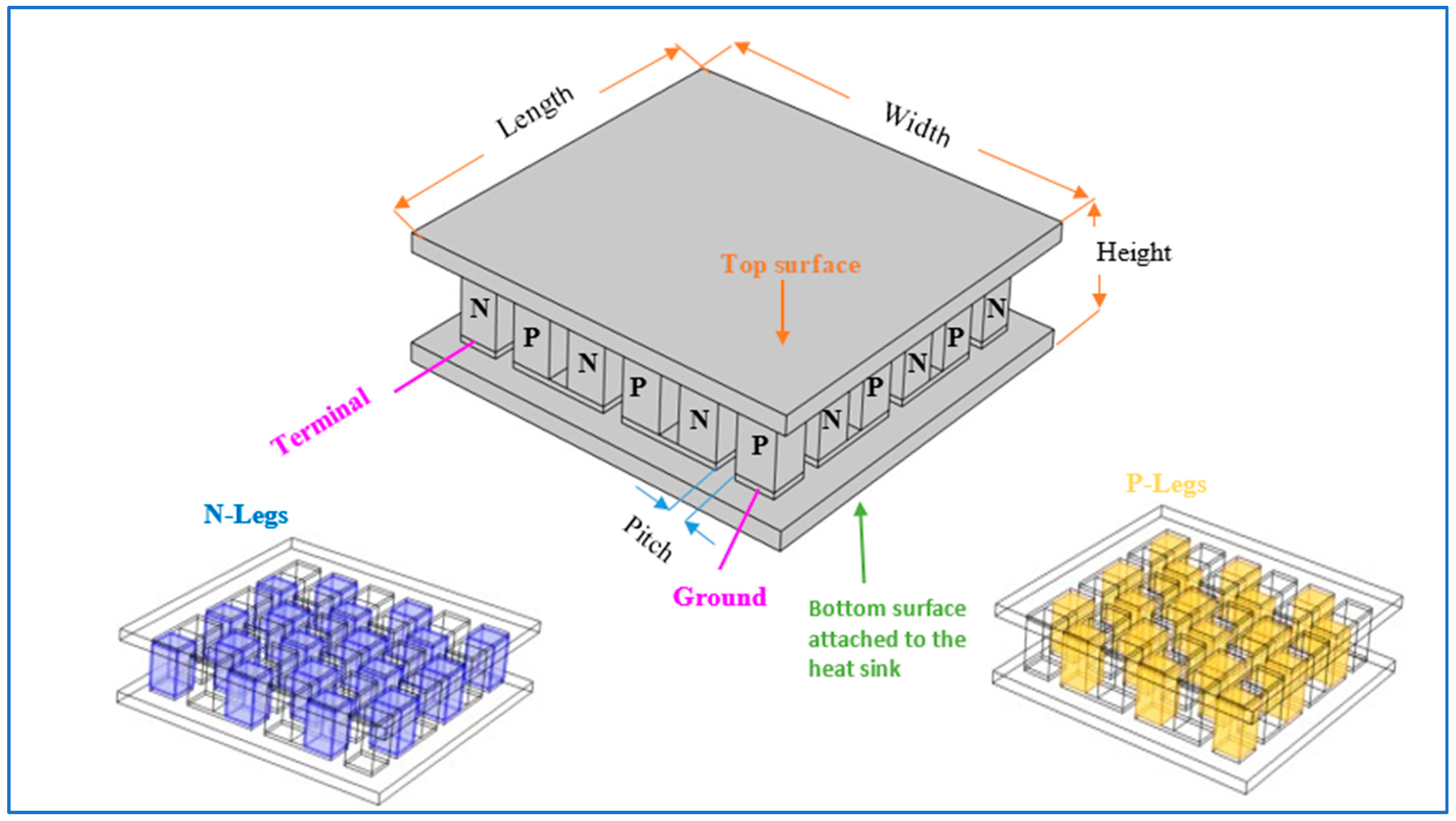
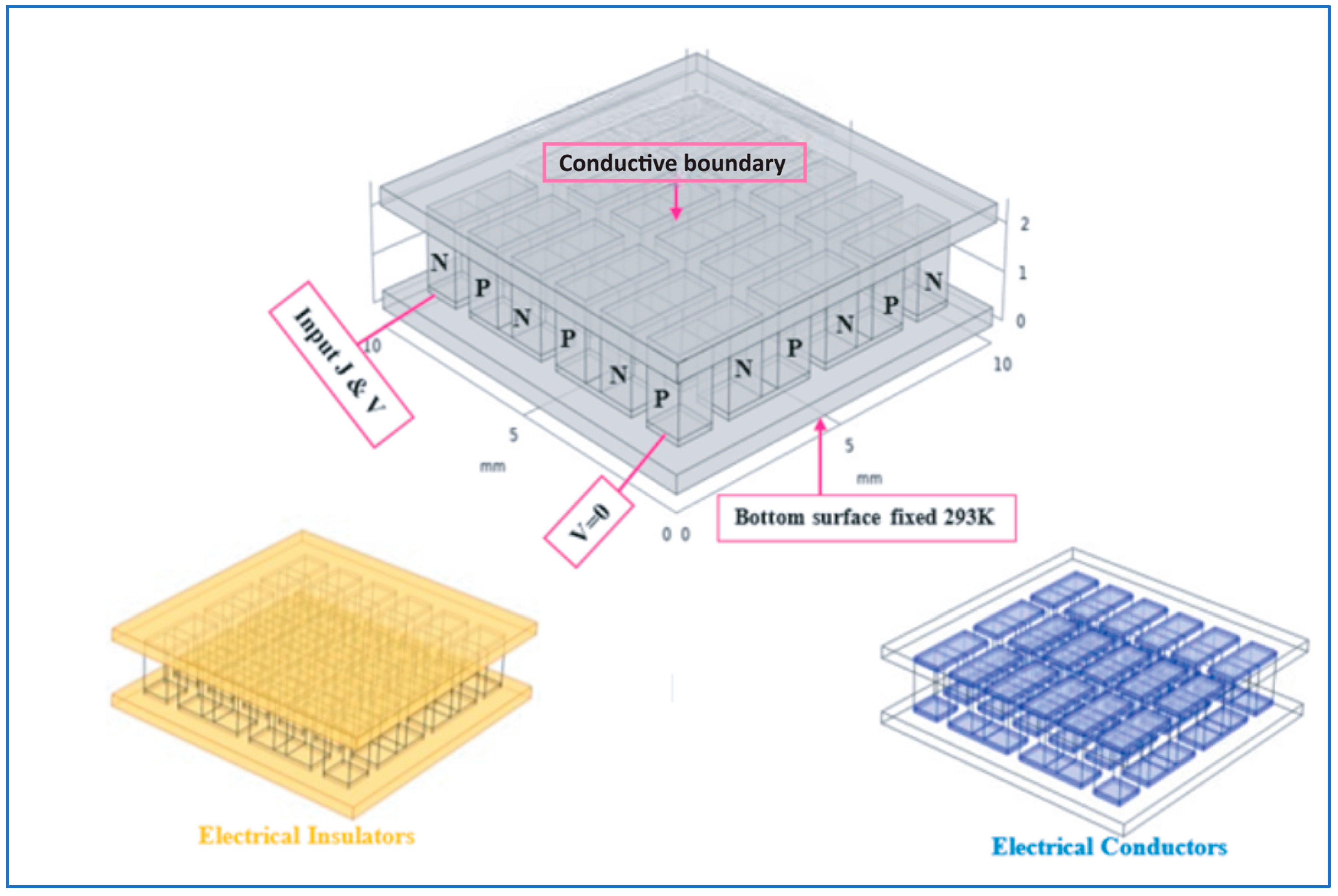
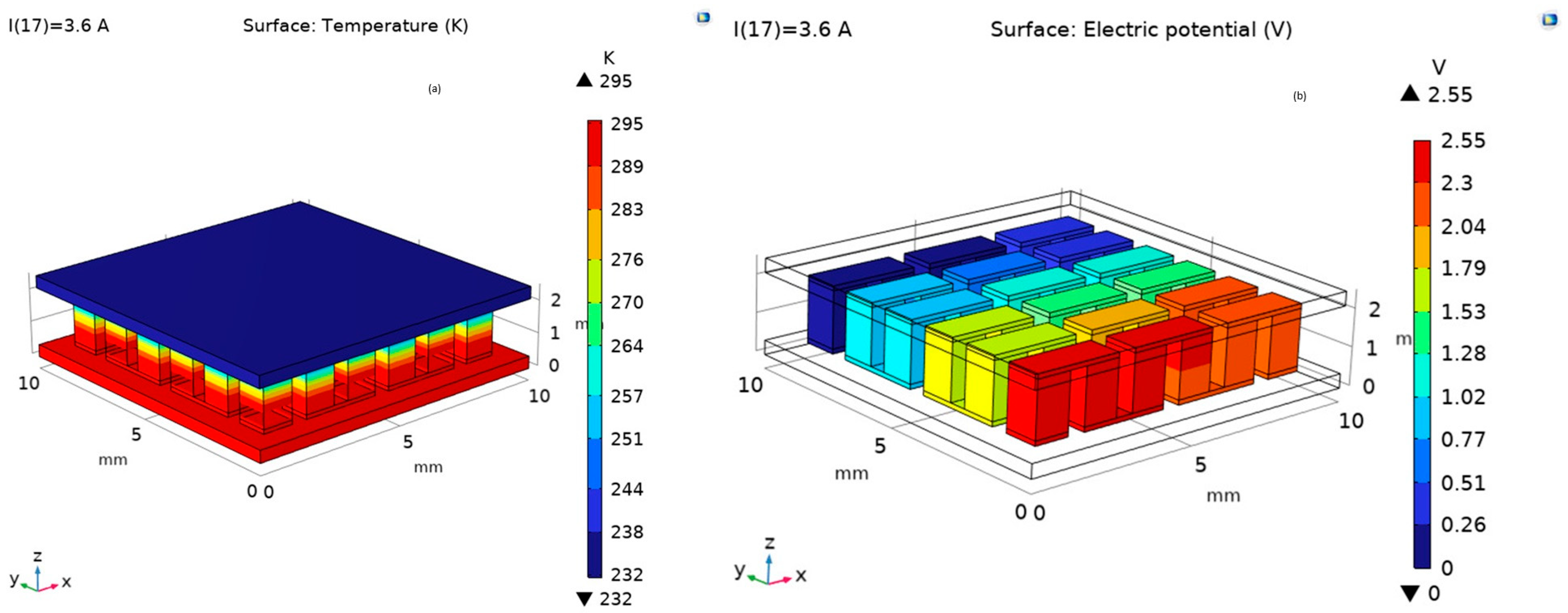

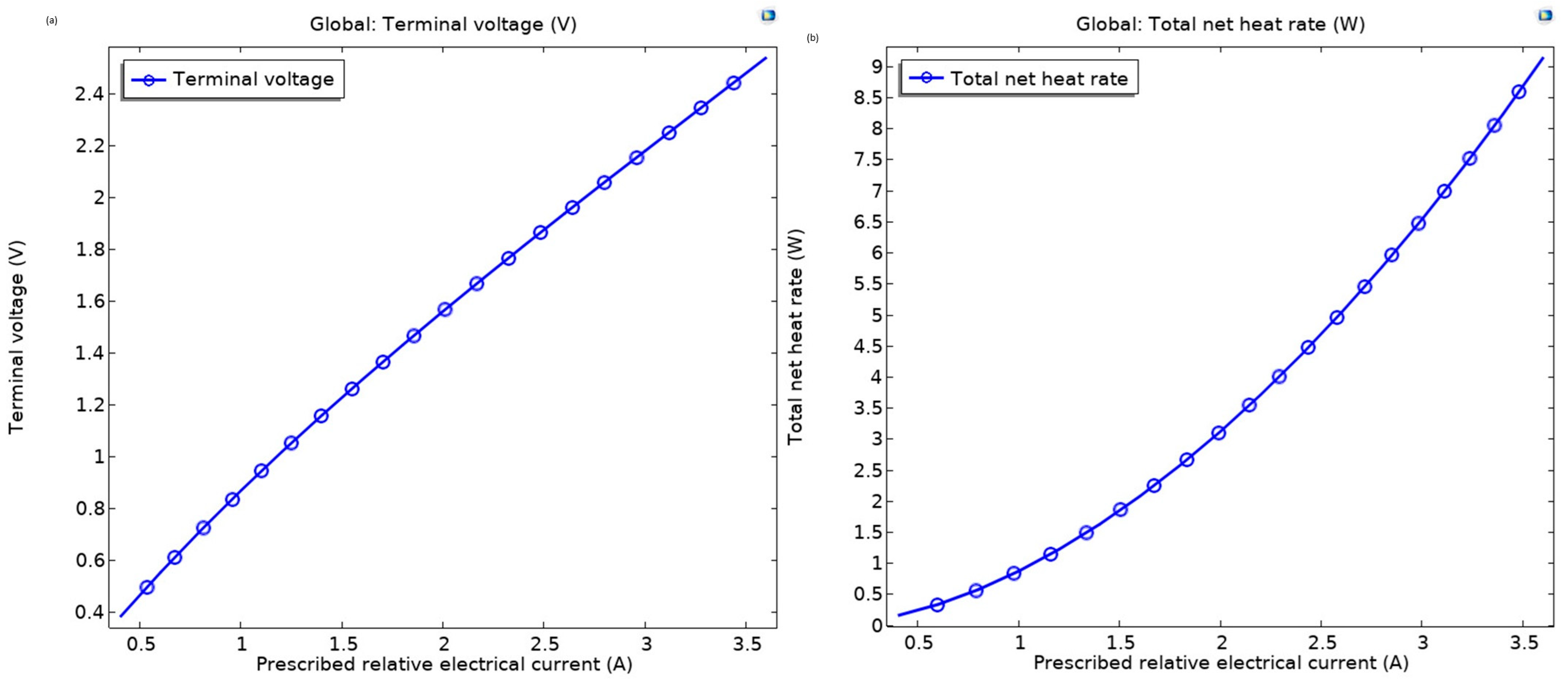
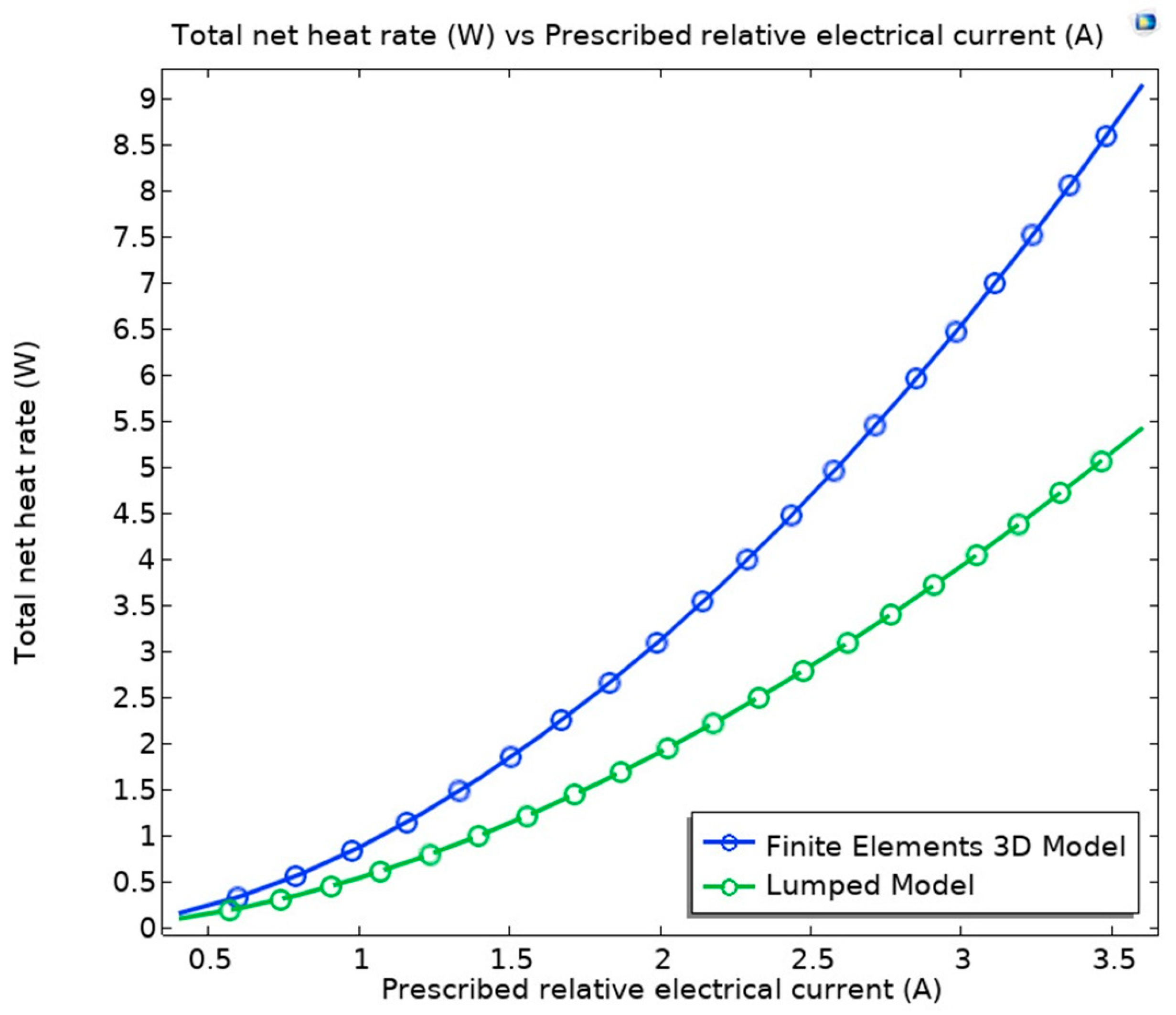

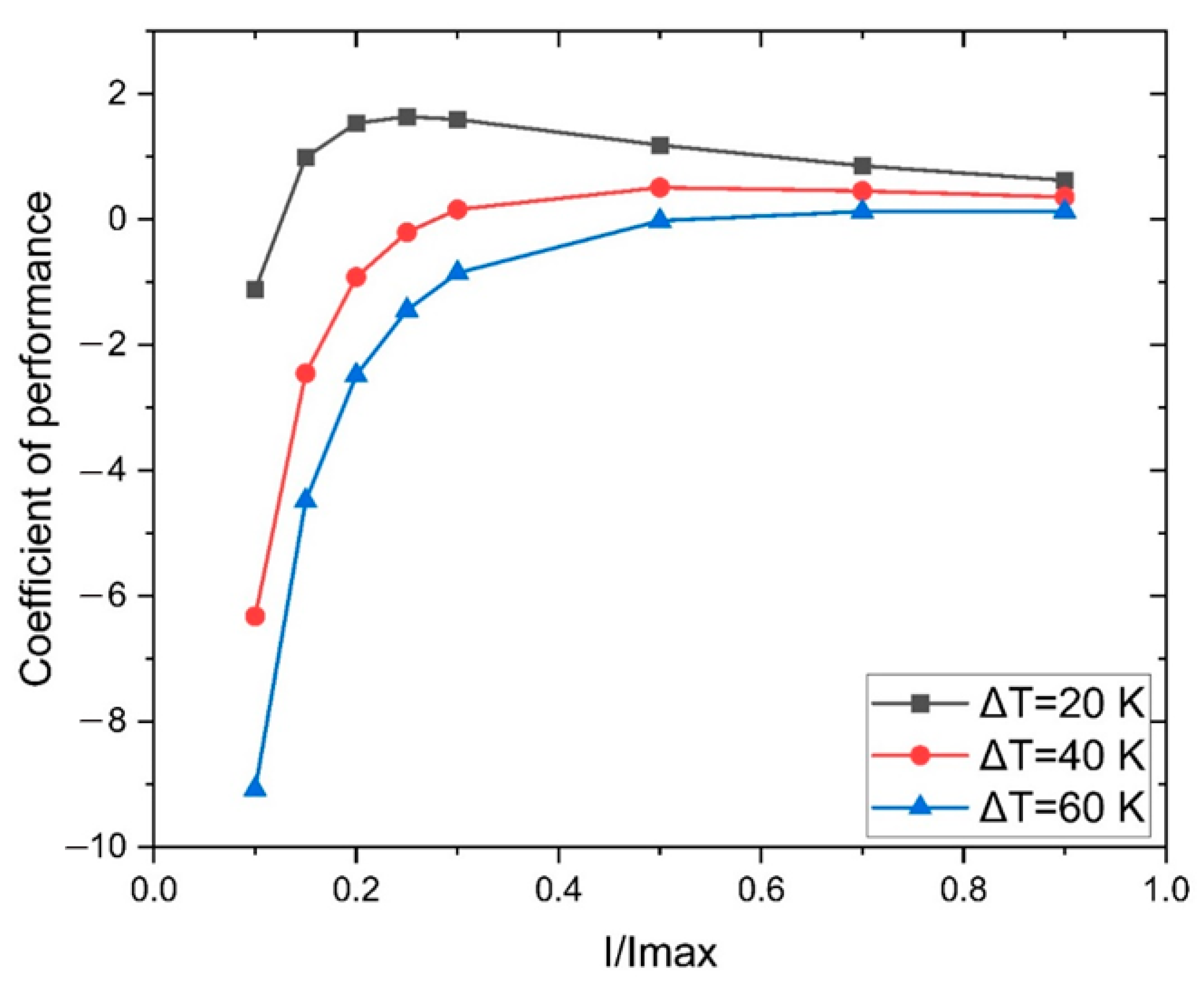


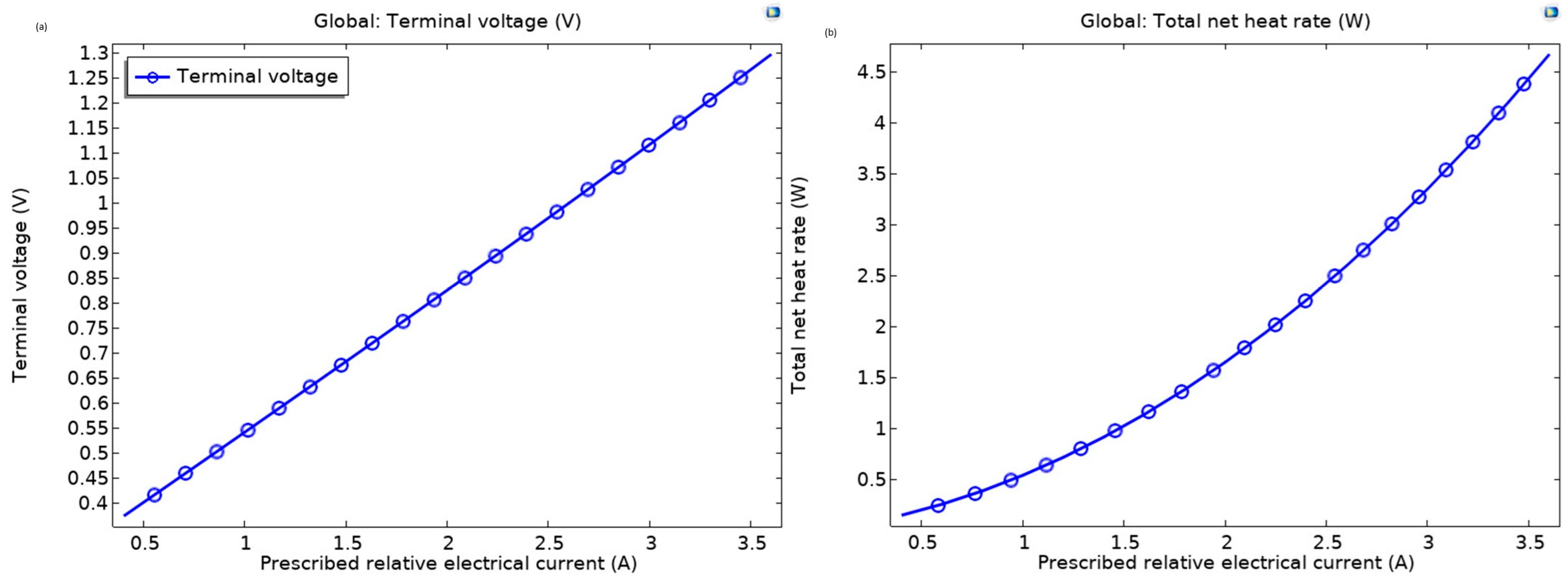

| Materials | S (V/K) | k (W/(m × K)) | σ (S/m) | ρ (kg/m3) | Cp (J/(kg × K)) |
|---|---|---|---|---|---|
| Al2O3 | 0.0 | 27 | 0.0 | 3900 | 900 |
| Cu | 0.0 | 400 | 5.998 × 107 | 8700 | 385 |
| p–type Bi2Te3 | S (T) | K (T) | Sigma (T) | 7700 | 154 |
| n–type Bi2Te3 | −S (T) | K (T) | Sigma (T) | 7700 | 154 |
Disclaimer/Publisher’s Note: The statements, opinions and data contained in all publications are solely those of the individual author(s) and contributor(s) and not of MDPI and/or the editor(s). MDPI and/or the editor(s) disclaim responsibility for any injury to people or property resulting from any ideas, methods, instructions or products referred to in the content. |
© 2025 by the authors. Licensee MDPI, Basel, Switzerland. This article is an open access article distributed under the terms and conditions of the Creative Commons Attribution (CC BY) license (https://creativecommons.org/licenses/by/4.0/).
Share and Cite
Kharmouch, A.; Hasan, M.K.; Sabik, E.Y.; Bouali, H.; Mamur, H.; Bhuiyan, M.R.A. Numerical Optimization of Multi-Stage Thermoelectric Cooling Systems Using Bi2Te3 for Enhanced Cryosurgical Applications. Thermo 2025, 5, 22. https://doi.org/10.3390/thermo5030022
Kharmouch A, Hasan MK, Sabik EY, Bouali H, Mamur H, Bhuiyan MRA. Numerical Optimization of Multi-Stage Thermoelectric Cooling Systems Using Bi2Te3 for Enhanced Cryosurgical Applications. Thermo. 2025; 5(3):22. https://doi.org/10.3390/thermo5030022
Chicago/Turabian StyleKharmouch, Akram, Md. Kamrul Hasan, El Yatim Sabik, Hicham Bouali, Hayati Mamur, and Mohammad Ruhul Amin Bhuiyan. 2025. "Numerical Optimization of Multi-Stage Thermoelectric Cooling Systems Using Bi2Te3 for Enhanced Cryosurgical Applications" Thermo 5, no. 3: 22. https://doi.org/10.3390/thermo5030022
APA StyleKharmouch, A., Hasan, M. K., Sabik, E. Y., Bouali, H., Mamur, H., & Bhuiyan, M. R. A. (2025). Numerical Optimization of Multi-Stage Thermoelectric Cooling Systems Using Bi2Te3 for Enhanced Cryosurgical Applications. Thermo, 5(3), 22. https://doi.org/10.3390/thermo5030022







